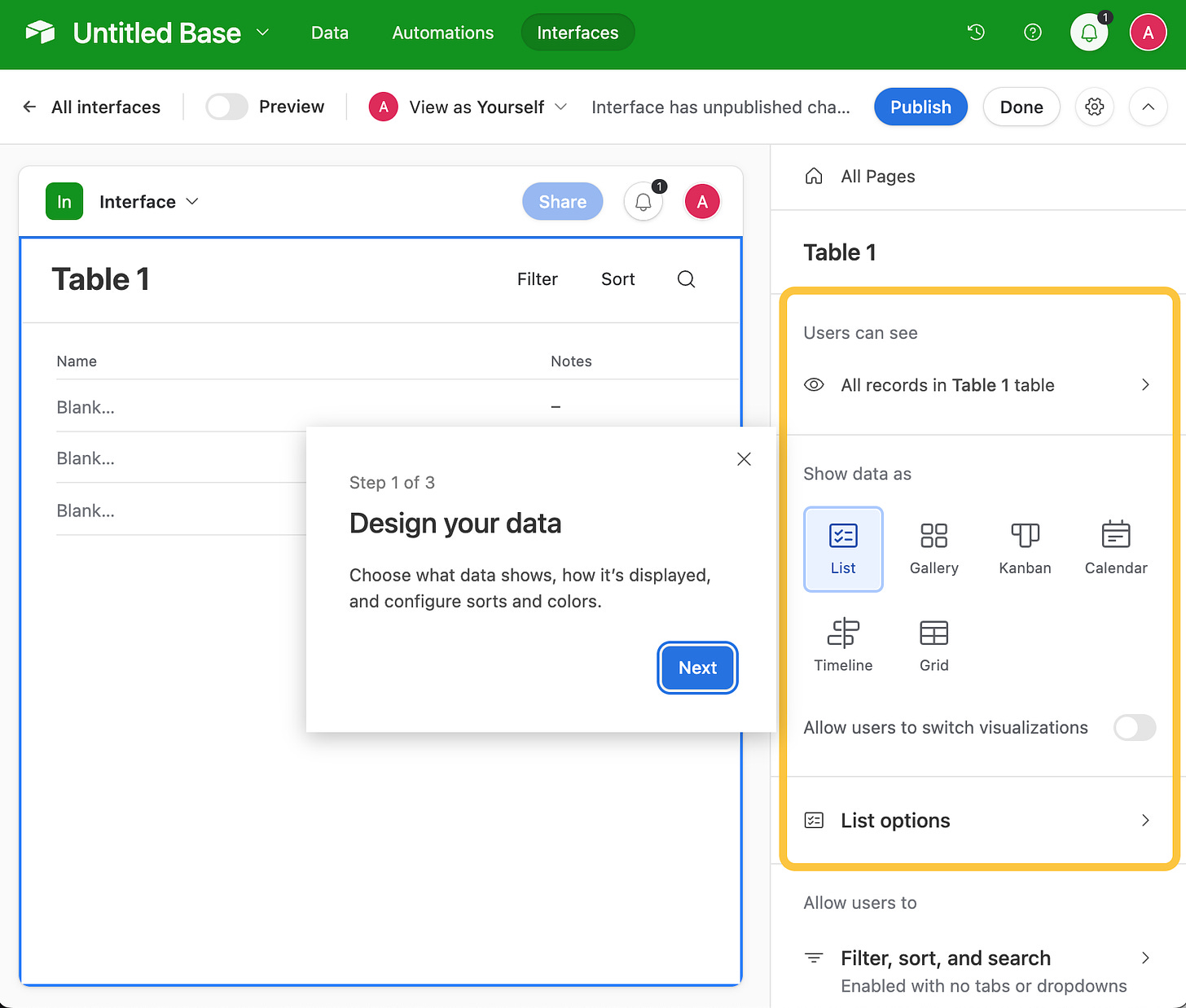Airtable is a cloud-based collaboration and database management platform that combines the functionality of a spreadsheet with the flexibility of a database. It was founded in 2013 by Howie Liu, Andrew Ofstad, and Emmett Nicholas. Airtable allows users to create custom tables, called "bases," with a variety of field types, such as text, numbers, dates, attachments, and more.
One of the key features of Airtable is its visual and user-friendly interface, which enables users to easily organize and manage their data. Bases can be customized with different views, including grid, calendar, gallery, and kanban, depending on the user's needs and preferences.
Airtable is popular among teams and individuals across various industries for managing projects, tracking inventory, organizing events, and other use cases. The platform offers integration with various other apps and services through its API and built-in automation features, making it a powerful and flexible tool for collaboration and data management.
How do you use it?
Using Airtable is relatively straightforward. To get started, follow these steps:
Sign up and create an account: Go to the Airtable website at www.airtable.com and sign up for a free account, or choose one of their paid plans for additional features and storage.
Create a new base: After signing up and logging in, click on the "Add a base" button to create a new base. You can start from scratch, import data from an existing source (such as CSV files, Google Sheets, or Excel), or choose a pre-built template that suits your needs.
Set up your table structure: Once your base is created, you'll see a default table with columns and rows that resemble a spreadsheet. Rename the table, and then add, modify, or delete columns to match the structure you need. You can set column types to text, numbers, dates, checkboxes, multiple-choice options, and more.
Enter your data: Populate the table with your data, either by manually entering the information or importing it from an external source. You can also attach files, images, or links to individual records.
Create views: Customize how you visualize and interact with your data by creating different views, such as grid, calendar, gallery, or kanban. To create a new view, click the "Add view" button and choose your desired format.
Filter, sort, and group records: Use the filtering, sorting, and grouping options to display your data in a way that makes sense for your specific needs. For example, you can filter records based on specific criteria, sort them alphabetically or by date, and group them by a particular field.
Collaborate with your team: Invite team members to your base by clicking on the "Share" button and entering their email addresses. You can assign different permission levels (read-only, editor, or owner) to each team member.
Automate tasks and integrate with other tools: Use Airtable's built-in automation features to streamline your workflow by automating repetitive tasks, such as sending notifications or updating records. You can also integrate Airtable with other apps and services through its API or by using services like Zapier or Integromat.
Where does it shine and struggle?
Airtable shines in:
User-friendliness: Airtable's intuitive interface makes it easy for users with little to no database experience to create, manage, and collaborate on their data.
Customization: With customizable tables, fields, and views, Airtable can be adapted to a wide range of use cases across various industries.
Collaboration: Real-time collaboration features make it easy for teams to work together, share information, and track progress on projects.
Multiple views: Grid, calendar, gallery, and kanban views enable users to visualize their data in different ways, making it easier to find and interpret information.
Automation and integration: Built-in automation features streamline workflows, and integration with other tools and services through APIs or platforms like Zapier extend its capabilities.
Airtable struggles in:
Complex database operations: While Airtable is great for simple to moderately complex use cases, it may not be the best fit for highly complex relational databases or advanced data analysis tasks that require more powerful query languages and features.
Performance and large datasets: As the size of your dataset grows, you may experience slowdowns in performance or hit limits on the number of records allowed per base, especially on the free plan.
Limited reporting and visualization tools: Although Airtable provides multiple views and some basic charting capabilities, it lacks advanced reporting and data visualization features that specialized tools like Tableau or Power BI offer.
Learning curve for advanced features: While Airtable is generally user-friendly, some users may find it challenging to master advanced features like complex formulas or automations.
Cost: While Airtable has a free plan, it comes with limitations on storage, records, and features. To unlock its full potential, users may need to subscribe to one of its paid plans, which can become expensive for larger teams or organizations.
What are the alternatives?
Notion: Notion is an all-in-one workspace that combines note-taking, task management, and database functionality. It's known for its flexible, modular structure that allows users to create pages, tables, lists, and more. Notion is great for teams and individuals looking for a more integrated solution for managing various aspects of their work.
Google Sheets: Google Sheets is a powerful and widely-used cloud-based spreadsheet tool that offers real-time collaboration, basic database management, and integrations with other Google Workspace applications. It's an excellent choice for users who primarily need spreadsheet functionality but with the added benefit of collaboration.
Microsoft Excel: Excel is a robust spreadsheet software that has been the industry standard for years. With the introduction of Excel Online and integration with Microsoft 365, it offers real-time collaboration and powerful data analysis features. Excel might be more suitable for users who require advanced calculations and data manipulation capabilities.
Trello: Trello is a project management and collaboration tool that uses a kanban-style board system for organizing tasks, projects, and teams. While it doesn't offer the same database functionality as Airtable, Trello is an excellent option for those focusing on project and task management.
ClickUp: ClickUp is a project management and productivity platform that offers features such as task management, document collaboration, goal tracking, and time tracking. It also provides custom fields and views, making it a flexible tool for managing and organizing projects and teams.
Smartsheet: Smartsheet is a cloud-based platform that combines spreadsheet, project management, and collaboration tools. It offers a more traditional spreadsheet-like interface with added features like automation, reporting, and integration with other tools. Smartsheet is well-suited for organizations looking for a more advanced and customizable spreadsheet-style solution.
Monday.com: Monday.com is a work operating system (Work OS) that includes project management, workflow automation, and collaboration features. It provides a highly customizable interface with a variety of views and templates, making it a suitable choice for teams looking for a comprehensive project management solution.





